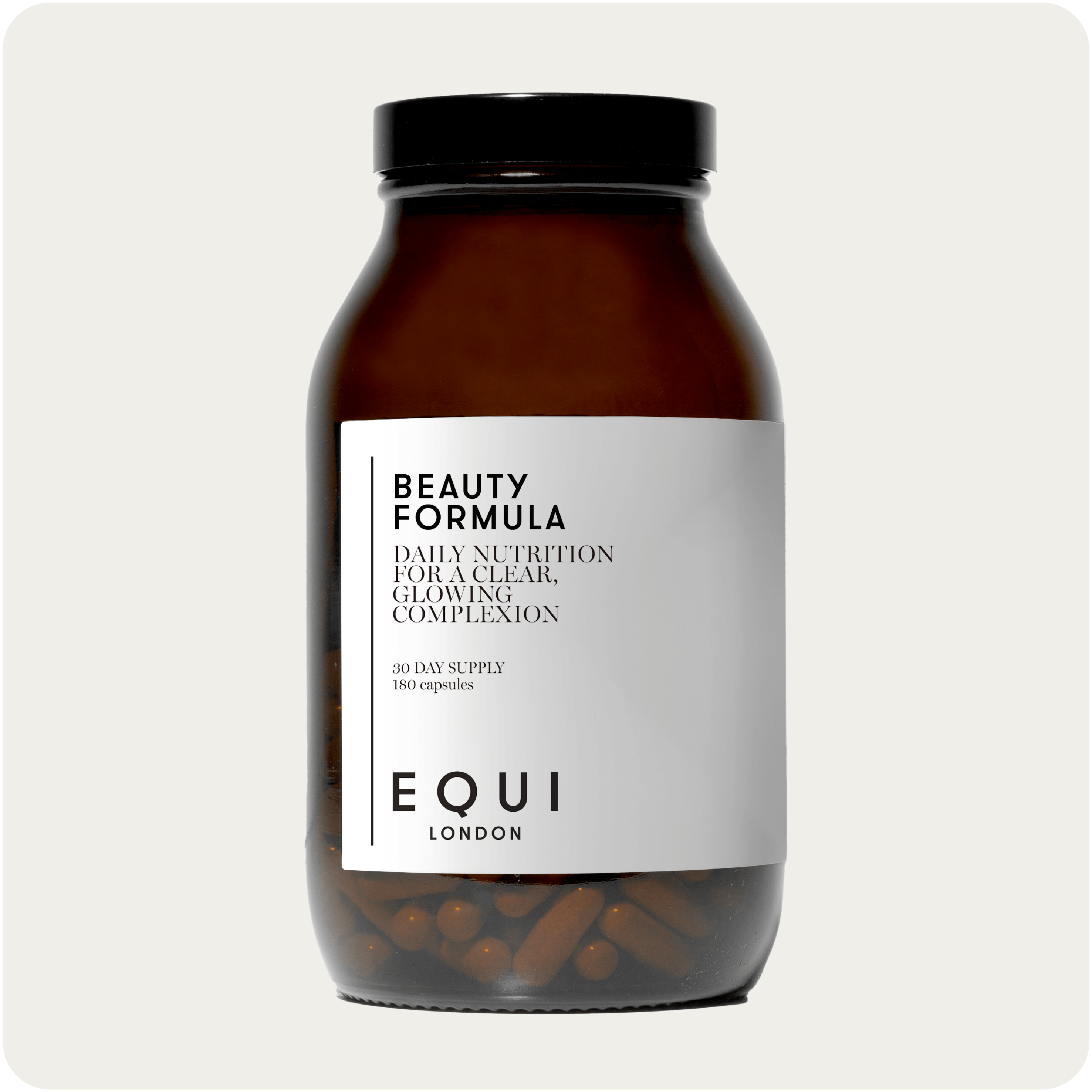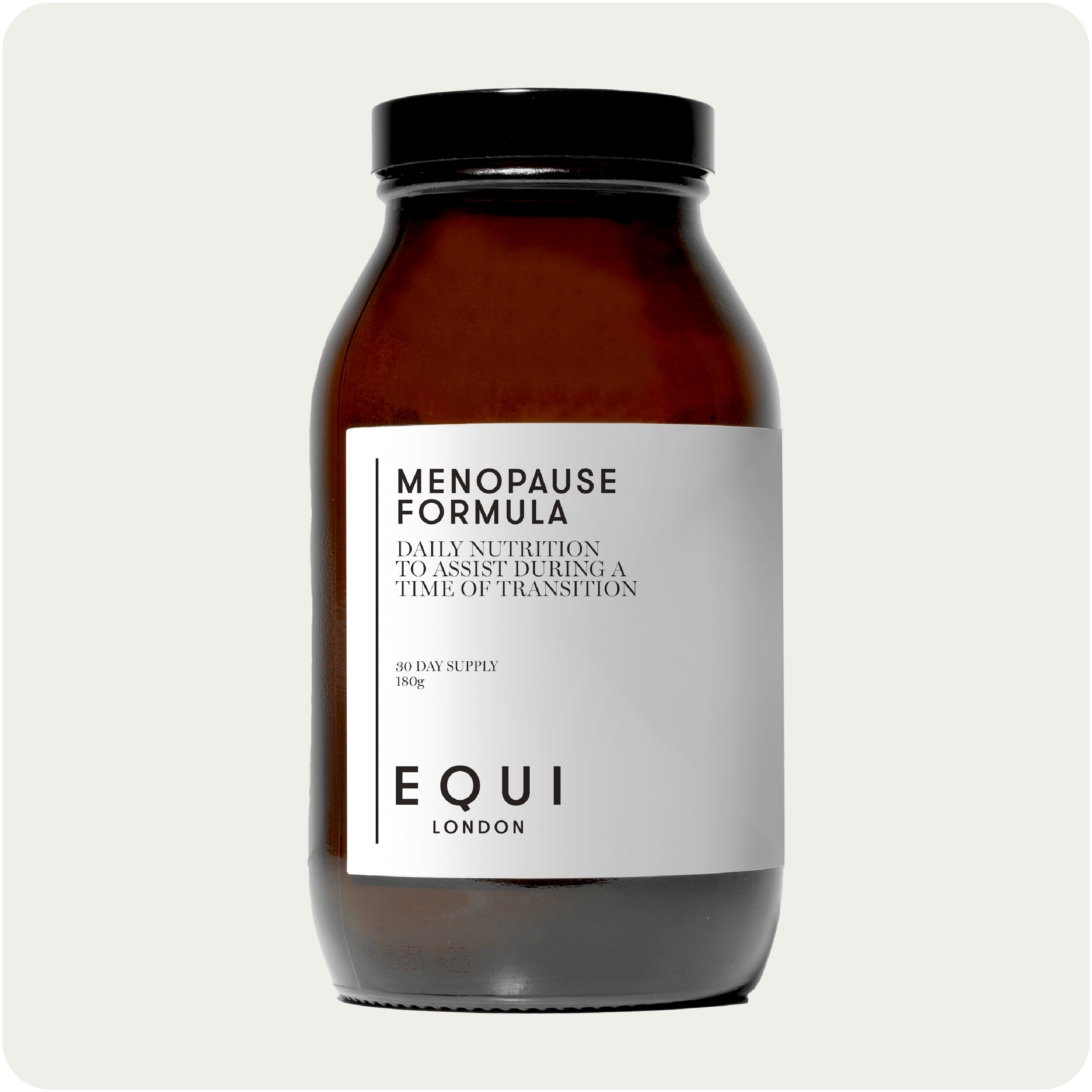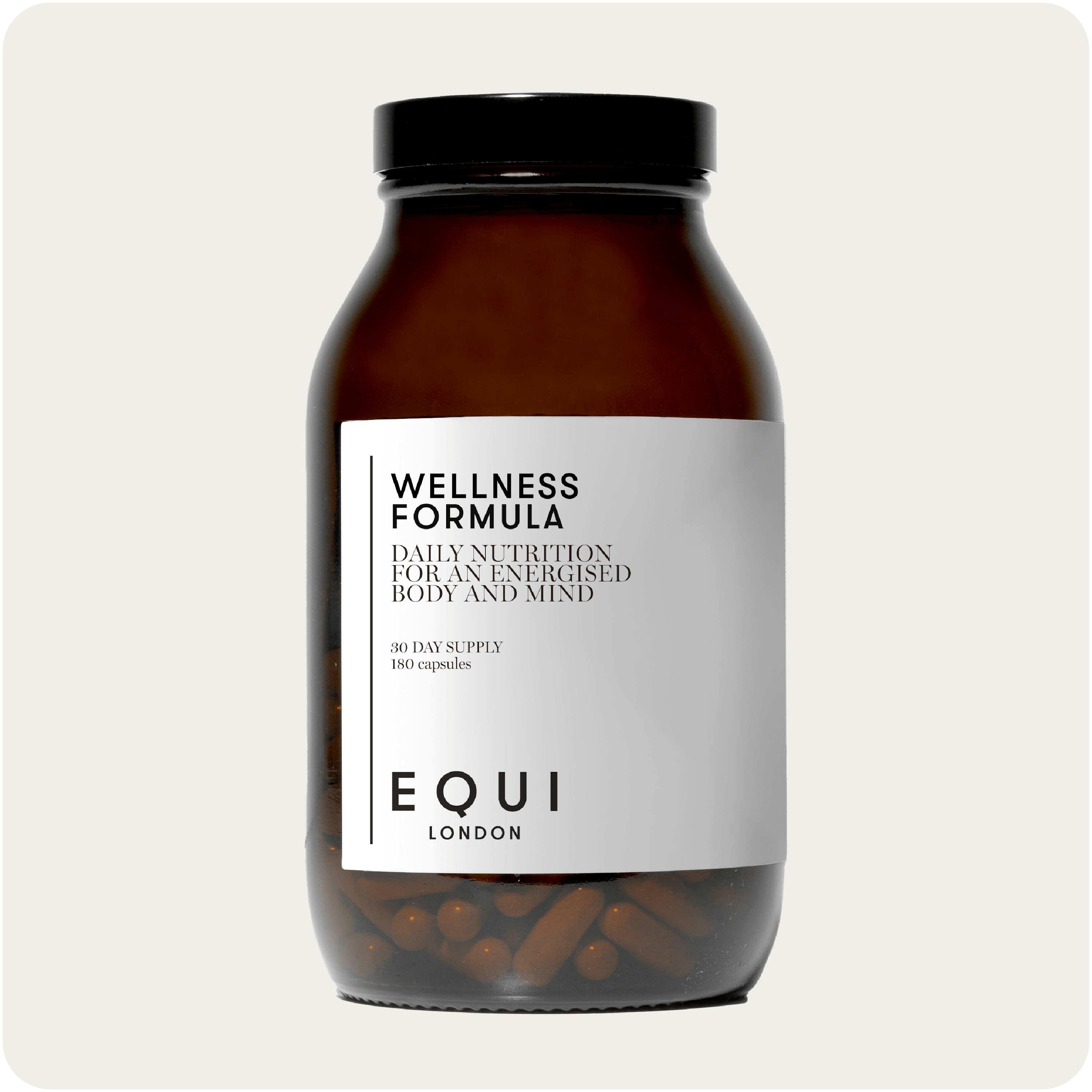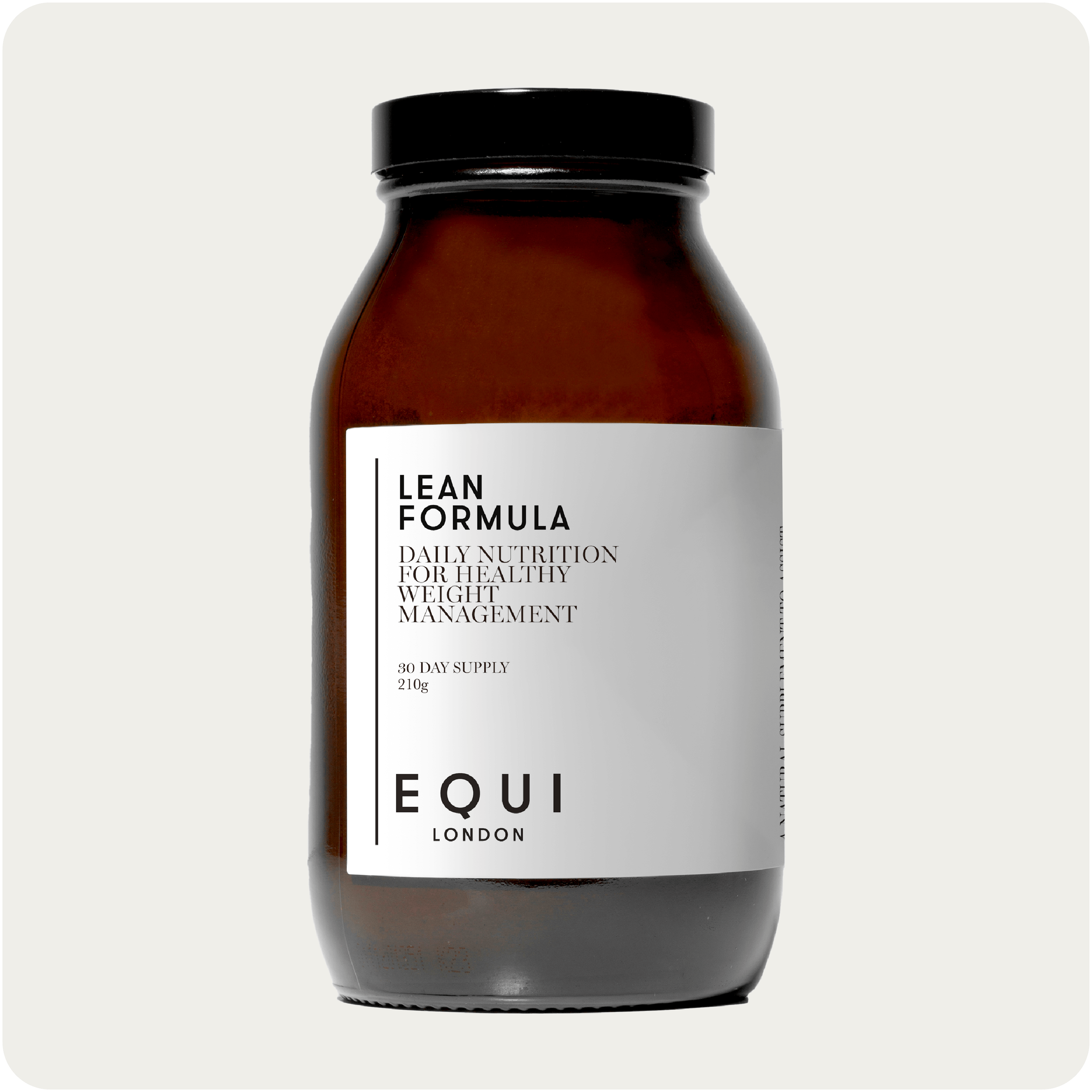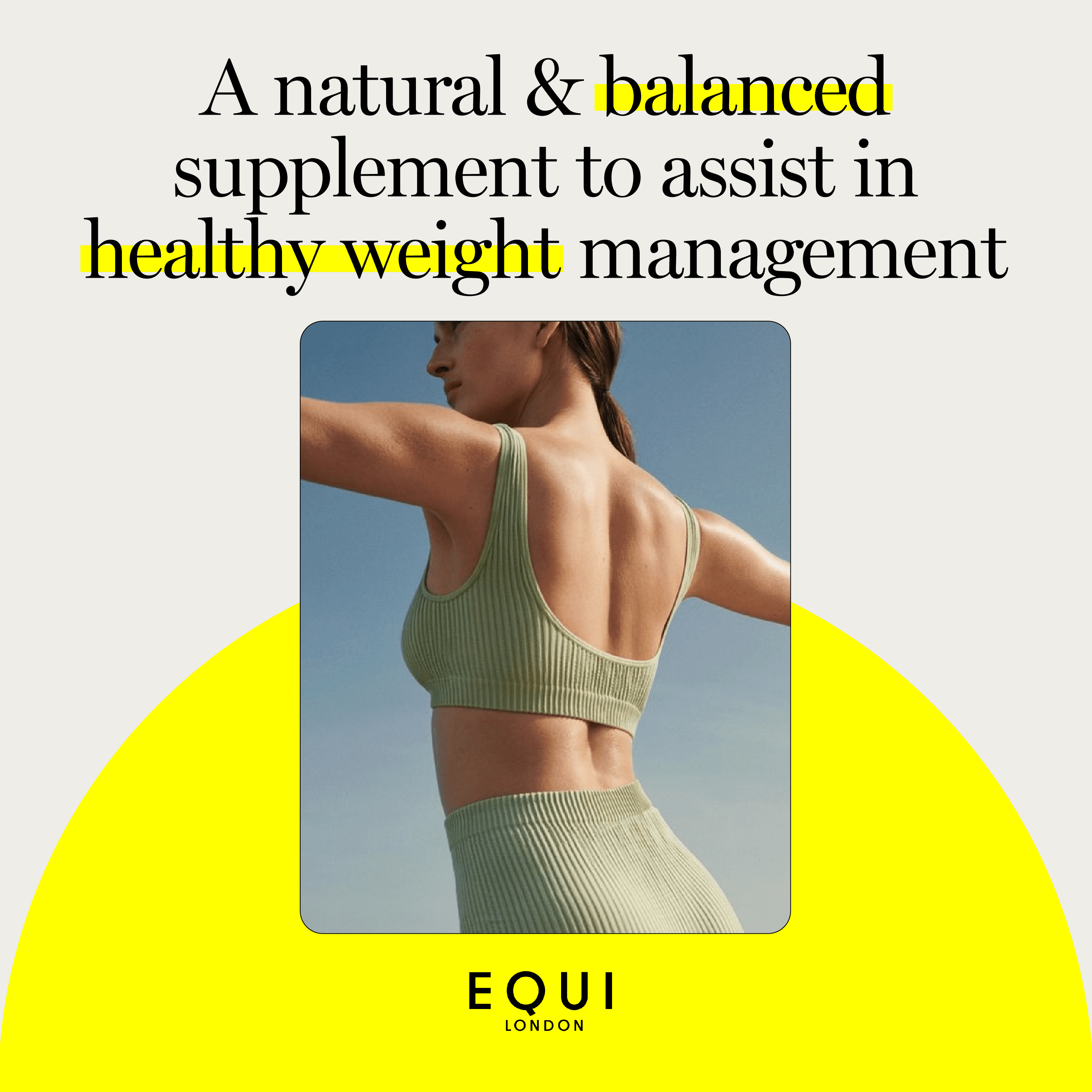Your skin is a reflection of your inner health, and what you eat plays a crucial role in its appearance and vitality. However, understanding what foods are best suited for your skin type can be a daunting task, especially when faced with an overwhelming array of dietary advice and skincare products. Many of us are unsure of our skin type in the first place, which can make it challenging to choose the right foods and skincare regimen. In today’s blog, we'll explore the four main skin types - normal, combination, dry, and oily - and discuss the specific dietary needs and nutrient deficiencies associated with each. Whether you have a smooth complexion or struggle with oily T-zones, dry patches, or blemishes, there are targeted nutrients and lifestyle considerations to help you achieve healthy, radiant skin from the inside out. But before we dive into the specifics of each skin type, let's introduce a powerful ally in your skincare journey: EQUI's Total Beauty which comprises Beauty Formula and Beauty Oil Edition. Beauty Formula is our innovative blend and contains over 45 highly effective nutritional compounds designed to target problem skin and brighten all complexions. Whether you're dealing with hormonal breakouts, fine lines, dark circles, redness, or signs of ageing, Beauty Formula has you covered. One of the standout features of Beauty Formula is its comprehensive approach to skincare. It not only promotes a clear and bright complexion but also addresses hormonal imbalances, lessens fine lines and dark circles, reduces redness, and supports overall wellbeing. Additionally, Beauty Formula nourishes and energises the body while promoting hair and nail health - a true multitasking powerhouse for skin and body wellness. Meanwhile, Beauty Oil Edition is the first beauty-specific omega 3 supplement and nature’s ultimate superfood for skin, supporting skin brightness and hydration.
For those fortunate enough to have normal skin, maintaining its balance is key to preserving its health and vitality. We'll explore how a varied diet rich in fruits, vegetables, lean proteins, and healthy fats can support normal skin function. Beauty Formula can complement this balanced diet by providing essential nutrients to promote clear, radiant skin and overall wellbeing. Combination skin presents unique challenges, with an oily T-zone and dry or normal cheeks. We'll discuss how targeted nutrition can help regulate oil production in the T-zone while providing hydration and nourishment to dry areas. Beauty Formula's comprehensive blend of nutrients can support both oily and dry areas, promoting balanced, healthy skin from within. Meanwhile, dry skin requires extra hydration and nourishment to restore its moisture barrier and alleviate tightness and flakiness. We'll explore nutrient-rich foods that can support hydration and skin barrier function, such as water-rich fruits and vegetables, vitamin E, and omega-6 fatty acids. Not only does Beauty Formula's holistic approach address dry skin but also supports hormone balance, gut health, and overall wellbeing. We also turn to Beauty Oil Edition which can help nourish the skin from the inside out. Finally, oily skin is characterised by excess sebum production and enlarged pores, often leading to blemishes and acne. We'll discuss how dietary strategies can help regulate oil production, reduce inflammation, and promote clearer, healthier skin. Beauty Formula's targeted ingredients can address hormonal breakouts and support skin health while nourishing the body from within. Understanding your skin type and addressing its specific needs through targeted nutrition is essential for achieving healthy, radiant skin. With the support of Total Beauty and a balanced diet tailored to your skin type, you can nourish your skin from the inside out and unleash its natural beauty.
The Normal Skin Diet - Nourishing Your Skin's Balance
Normal skin is often considered the gold standard of skin types, characterised by a harmonious balance of oil production, hydration, and overall health. Those lucky enough to have normal skin typically experience few to no skin concerns, as their complexion remains consistently comfortable, smooth, and blemish-free. Identifying normal skin involves recognising specific characteristics and maintaining a balanced diet and lifestyle to preserve its health and vitality.
Characteristics of Normal Skin
Balanced Oil Production - Normal skin is neither too oily nor too dry, with sebum production occurring at an optimal level. This balance helps maintain the skin's natural moisture barrier without causing excessive shine or dryness.
Comfortable Texture - Normal skin feels comfortable to the touch, with a smooth and supple texture. It lacks the roughness or tightness associated with dry skin and the greasiness of oily skin.
Minimal Blemishes - Those with normal skin typically experience minimal blemishes, such as acne breakouts, blackheads, or whiteheads. Their complexion remains clear and even toned, with few visible imperfections.
Healthy Appearance - Normal skin has a healthy appearance, with a radiant complexion and balanced skin tone. It is not prone to redness, irritation, or sensitivity, indicating overall skin health.
Maintaining normal skin involves adopting a balanced diet rich in essential nutrients that support skin health and overall wellbeing. Numerous studies have highlighted the importance of specific nutrients in promoting healthy skin function and preserving its youthful appearance.
Nutrient-Rich Foods for Normal Skin
Fruits and Vegetables - Colourful fruits and vegetables are rich in vitamins, minerals, and antioxidants that protect the skin from oxidative stress and inflammation. Consuming a variety of fruits and vegetables ensures adequate intake of essential nutrients like vitamin C, vitamin E, and beta-carotene, which support collagen production, skin elasticity, and overall skin health (1).
Lean Proteins - Lean proteins, such as poultry, fish, tofu, and legumes, provide amino acids essential for collagen synthesis and tissue repair. Including lean proteins in the diet helps maintain skin elasticity, firmness, and resilience, promoting a youthful complexion (2).
Healthy Fats - Incorporating healthy fats from sources like avocados, nuts, seeds, and fatty fish provides essential fatty acids that support skin hydration and barrier function. Omega-3 fatty acids, in particular, have anti-inflammatory properties and help maintain skin moisture levels, contributing to a smooth and supple complexion.
Whole Grains - Whole grains like brown rice, quinoa, oats, and barley are rich in fibre, vitamins, and minerals that support overall health, including skin health. Fibre aids in digestion and promotes gut health, which is closely linked to skin health and immune function.
Maintaining overall health through regular exercise, adequate hydration, stress management, and sufficient sleep also plays a crucial role in preserving normal skin function. Exercise improves blood circulation, delivering oxygen and nutrients to the skin, while hydration helps maintain skin moisture levels and detoxification processes. Additionally, managing stress reduces the production of stress hormones like cortisol, which can negatively impact skin health and contribute to inflammation and premature ageing (3).
In conclusion, normal skin is characterised by its balanced oil production, comfortable texture, smooth appearance, and minimal blemishes. Maintaining normal skin involves consuming a varied diet rich in fruits, vegetables, lean proteins, and healthy fats to support skin health and overall wellbeing. By nourishing the body with essential nutrients and adopting healthy lifestyle habits, individuals can preserve the health and vitality of their skin for years to come.
Balancing Act - Nutrition for Combination Skin
Combination skin is a common skin type characterised by a unique blend of oily and dry areas on the face. The most typical manifestation of combination skin is an oily T-zone, which includes the forehead, nose, and chin, contrasted with dry or normal cheeks. This combination of skin characteristics presents a challenge for those seeking to maintain a balanced complexion, as they must address the needs of both oily and dry areas simultaneously.
Common Characteristics of Combination Skin
Oily T-Zone - The T-zone tends to produce excess sebum, leading to a shiny or greasy appearance. Enlarged pores and occasional acne breakouts may also occur in this area.
Dry or Normal Cheeks - The cheeks may feel dry, tight, or rough, particularly after cleansing or exposure to environmental factors. They may also appear dull or flaky in some cases.
Identifying combination skin involves recognising these distinct characteristics and tailoring skincare and dietary habits to address the specific needs of each area.
Potential Nutrient Deficiencies and Imbalances
Several nutrient deficiencies and imbalances may contribute to the development or exacerbation of combination skin. Inadequate hydration is a common culprit, as dehydration can lead to dryness and tightness in certain areas of the face. Essential fatty acid deficiencies, particularly omega-3 fatty acids, may also play a role in imbalances within the skin's lipid barrier, contributing to both dryness and excess oil production.
Dietary Tips for Supporting Combination Skin
Hydration Strategies - Adequate hydration is essential for maintaining skin health and preventing dryness. Individuals with combination skin should aim to drink plenty of water throughout the day to support overall hydration. Additionally, incorporating hydrating foods such as cucumbers, watermelon, and citrus fruits can help boost moisture levels in the skin and have the added bonus of being rich in antioxidants such as vitamin C, which further support skin health.
Foods Rich in Omega-3 Fatty Acids - Omega-3 fatty acids are renowned for their anti-inflammatory properties and ability to support skin health. Including omega-3-rich foods like fatty fish (salmon, mackerel, sardines), flaxseeds, chia seeds, and walnuts in the diet can help balance oil production and reduce inflammation in oily areas while nourishing dry areas (4).
Balanced Diet - Consuming a balanced diet rich in fruits, vegetables, lean proteins, and healthy fats is essential for supporting overall skin health. Nutrient-dense foods provide vitamins, minerals, and antioxidants that promote skin repair, regeneration, and protection against environmental damage.
Hormonal fluctuations, particularly during the monthly cycle, pregnancy, or menopause, can exacerbate combination skin issues by influencing sebum production and skin hydration levels (5). Stress is another factor that can trigger hormonal imbalances and worsen skin conditions, including acne and dryness (6).
In conclusion, combination skin presents a unique set of challenges characterised by an oily T-zone and dry or normal cheeks. Nutrient deficiencies, inadequate hydration, and hormonal fluctuations can contribute to imbalances within the skin, exacerbating these issues. However, adopting dietary strategies that prioritise hydration, omega-3 fatty acids, and a balanced diet can help support both oily and dry areas of the skin, promoting a more balanced complexion.
Quenching Thirsty Skin - Foods for Dry Skin
Dry skin, also known as xerosis, is a common skin condition characterised by a lack of moisture and lipid content in the skin, leading to various symptoms such as tightness, roughness, and flakiness. Understanding the signs and potential nutrient deficiencies associated with dry skin is essential for implementing effective dietary and lifestyle interventions to improve skin hydration and barrier function.
Symptoms of Dry Skin
Tightness - Dry skin often feels tight, especially after cleansing or exposure to harsh environmental conditions. This sensation is due to a lack of moisture and lipid content in the skin, leading to decreased elasticity and flexibility.
Roughness - Dry skin may have a rough or uneven texture, with areas that feel coarse or bumpy to the touch. This roughness is caused by the build-up of dead skin cells on the skin's surface, which is exacerbated by dehydration and impaired skin barrier function.
Flakiness - Flakiness is a common symptom of dry skin, characterised by the shedding of small, dry flakes of skin. These flakes may appear white or translucent and can be particularly noticeable on areas like the cheeks, elbows, and knees.
Nutrient Deficiencies Associated with Dry Skin
Several nutrient deficiencies may contribute to the development or exacerbation of dry skin, including insufficient intake of water, vitamins, and essential fatty acids. Inadequate hydration can impair the skin's ability to retain moisture, leading to dehydration and dryness (7). Similarly, deficiencies in vitamins such as vitamin E, which acts as an antioxidant and helps protect the skin from oxidative damage, can compromise skin barrier function and contribute to dryness (8). Essential fatty acids, particularly omega-6 fatty acids like linoleic acid, play a crucial role in maintaining skin hydration and barrier function (9).
Dietary Recommendations for Supporting Dry Skin
Hydrating Foods - Consuming foods rich in water content, such as fruits and vegetables like cucumbers, watermelon, oranges, and tomatoes, can help hydrate the skin from within and support overall skin health thanks to the presence of antioxidants such as vitamin C.
Vitamin E-Rich Foods - Incorporating foods high in vitamin E, such as almonds, sunflower seeds, spinach, and avocado, into the diet can help protect the skin from oxidative damage and improve skin barrier function.
Omega-6 Fatty Acids - Including sources of omega-6 fatty acids like safflower oil, pumpkin seeds and walnuts in the diet can help replenish lipid levels in the skin and support barrier function.
Zinc - Zinc is an essential mineral that plays a key role in skin health and wound healing. Adequate zinc intake supports skin cell turnover and regeneration, contributing to smoother, healthier skin (10).
In addition to dietary interventions, lifestyle factors such as adequate hydration and skincare routines are crucial for managing dry skin. Drinking plenty of water throughout the day helps maintain skin hydration levels and supports overall skin health. Additionally, implementing a skincare regimen that includes gentle cleansing, moisturising, and sun protection can help prevent further dryness and protect the skin from environmental damage.
In conclusion, dry skin is characterised by symptoms such as tightness, roughness, and flakiness, which can be attributed to various nutrient deficiencies and lifestyle factors. By addressing these underlying causes through dietary interventions rich in hydrating foods, vitamin E, omega-6 fatty acids, and zinc, we can support skin hydration and barrier function. Additionally, prioritising lifestyle factors like adequate hydration and a nourishing skincare routine plays a crucial role in managing dry skin and promoting overall skin health.
Taming the Shine - Nutrition Tips for Oily Skin
Oily skin is a common skin type characterised by excess sebum production, enlarged pores, and a shiny or greasy appearance. Those with oily skin may also be prone to acne breakouts and blackheads due to the accumulation of oil and dead skin cells in the pores. Understanding the characteristics of oily skin and potential underlying factors, including nutrient deficiencies and imbalances, is essential for implementing effective dietary and lifestyle strategies to regulate oil production and promote skin health.
Characteristics of Oily Skin
Excess Sebum Production - Oily skin is characterised by overactive sebaceous glands that produce an excessive amount of sebum, or skin oil. This excess oil can lead to a shiny or greasy appearance, particularly in the T-zone area (forehead, nose, and chin).
Enlarged Pores - Oily skin often has visibly enlarged pores, especially in areas where sebum production is most pronounced. Enlarged pores can become clogged with oil, dirt, and dead skin cells, leading to acne breakouts and blackheads.
Acne Breakouts - The combination of excess sebum production and clogged pores makes those with oily skin more prone to acne breakouts, including whiteheads, blackheads, and inflammatory acne lesions.
Potential Nutrient Deficiencies or Imbalances
Several dietary factors may contribute to oily skin, including excess consumption of processed foods, high glycaemic index foods, and imbalanced omega-3 to omega-6 fatty acid ratios. Diets high in processed foods, refined sugars, and unhealthy fats can promote inflammation and sebum production in the skin, exacerbating oily skin symptoms (11). Imbalanced ratios of omega-3 to omega-6 fatty acids, with an excess of omega-6 fatty acids relative to omega-3s, may also contribute to inflammation and oiliness in the skin (12). Furthermore, the liver plays a crucial role in detoxification and hormone regulation, which are closely linked to oily skin. Hormonal imbalances, such as elevated androgens or insulin resistance, can stimulate sebum production and contribute to oily skin and acne. Supporting liver health through dietary and lifestyle interventions, such as consuming antioxidant-rich foods and avoiding excessive alcohol and processed foods, can help improve hormone balance and reduce breakouts in individuals with oily skin.
Dietary Strategies for Oily Skin
Antioxidant-Rich Foods - Consuming foods rich in antioxidants, such as fruits, vegetables, and green tea, can help reduce inflammation and oxidative stress in the skin, promoting a healthier complexion.
Fibre-Rich Foods - Fibre-rich foods like whole grains, legumes, and vegetables support digestive health and may help regulate hormone levels, reducing sebum production and oiliness in the skin.
Omega-3 Fatty Acids - Including sources of omega-3 fatty acids, such as fatty fish (salmon, mackerel, sardines), flaxseeds, and walnuts, in the diet can help reduce inflammation and balance sebum production in oily skin (13).
Lifestyle factors such as stress and hormonal fluctuations can exacerbate oily skin symptoms. Stress triggers the release of cortisol, a stress hormone that can stimulate sebum production and lead to acne breakouts (14). Managing stress through relaxation techniques, regular exercise, and adequate sleep can help reduce oiliness and promote skin health in those of us with oily skin.
In conclusion, oily skin is characterised by excess sebum production, enlarged pores, and acne breakouts, which can be influenced by dietary and lifestyle factors. Addressing nutrient deficiencies or imbalances, supporting liver detoxification, and adopting dietary strategies rich in antioxidants, fibre, and omega-3 fatty acids can help regulate oil production and promote healthier skin. Additionally, managing stress and hormonal fluctuations through lifestyle modifications is essential for managing oily skin effectively.
How Total Beauty Supports Every Skin Type
Beauty Formula and Beauty Oil Edition are two powerful supplements designed to support all skin types by addressing key aspects of skin health and nourishment. Let's delve into how each of these supplements works synergistically to promote radiant, healthy skin. Starting with Beauty Formula, its star ingredient is EQUI's proprietary GlowCutis® blend. This blend is a collagen-stimulating, antioxidant powerhouse containing Hyaluronic Acid, Type 1 Marine Collagen peptides, Zinc, Vitamin C, Pine Bark Extract, Resveratrol, and Silica. These ingredients work together to support every stage of the skin cell cycle, strengthening the skin and helping to counteract premature aging. Marine Collagen peptides, derived from sustainably sourced seafood, are carefully hydrolysed to ensure maximum bioavailability, nourishing the skin to maintain elasticity and suppleness. Acerola Cherry provides a potent source of Vitamin C, essential for collagen production, while adaptogenic herbs and Vitamin B6 support hormonal balance, a crucial aspect of skin health. Additionally, advanced multivitamins and minerals, including B-vitamins, Magnesium, Iron, Biotin, Selenium, and Niacin support epidermal cell health. Vegan probiotics aid digestion and diminish water retention, while supergrasses and berries provide plant-based nutrients to aid cleansing. Turmeric extract reduces inflammation and enhances gut health, while Vitamins D, Zinc, and Selenium support overall immune function and skin health.
Now, let's explore how Beauty Oil Edition complements Beauty Formula to support all skin types. Beauty Oil Edition contains EPA and DHA omegas, essential fatty acids that counteract redness and dryness, resulting in smoother, firmer, and more elastic skin with reduced lines. The plumping Krill Oil is rich in omega-3 fatty acids, offering anti-inflammatory and hydrating properties. Astaxanthin, a potent skin antioxidant naturally found in Krill, helps combat oxidative stress and protect the skin from environmental damage. Hydrating Choline conditions the skin's cells, while anti-inflammatory DHA and EPA calm and hydrate, reducing dry patches and redness for an overall radiant complexion.
By combining Beauty Formula and Beauty Oil Edition, you can address a wide range of skin concerns and support all skin types. Beauty Formula provides essential nutrients, antioxidants, and collagen support to nourish the skin from within, while Beauty Oil Edition delivers omega-3 fatty acids and additional skin-loving ingredients to promote hydration, elasticity, and a youthful glow. Whether dealing with oily, dry, combination, or normal skin, these supplements work together to promote optimal skin health and vitality. By incorporating these supplements into a daily skincare routine, you can nourish your skin from the inside out, resulting in a radiant, healthy complexion. Shop Total Beauty here.
References
- Pullar JM, et al. (2017). The Roles of Vitamin C in Skin Health. Nutrients.9(8), pp. 866.
- Wu G, et al. (2009). Amino acids: metabolism, functions, and nutrition. Amino Acids.37(1), pp. 1-17.
- Reich A, Wójcik-Maciejewicz A, Slominski AT. (2010). Stress and the skin. G Ital Dermatol Venereol. 145(2), pp. 213-9.
- Barcelos RC, et al. (2015). Oral supplementation with fish oil reduces dryness and pruritus in the acetone-induced dry skin rat model. J Dermatol Sci. 79(3), pp. 298-304.
- Zouboulis CC, et al. Acne as a chronic systemic disease. Clin Dermatol. 2014;32(3), pp. 389-396.
- Reich A, Wójcik-Maciejewicz A, Slominski AT. (2010). Stress and the skin. G Ital Dermatol Venereol. 145(2), pp. 213-9.
- Palma L, et al. (2015). Dietary water affects human skin hydration and biomechanics. Clin Cosmet Investig Dermatol. 8, pp. 413-421.
- Keen MA, et al. Vitamin E in dermatology. Indian Dermatol Online J. 2016;7(4):311-315.
- Parke MA, Perez-Sanchez A, Zamil DH, Katta R. (2021). Diet and Skin Barrier: The Role of Dietary Interventions on Skin Barrier Function. Dermatol Pract Concept.;11(1):e2021132.
- Gupta M, Mahajan VK, Mehta KS, Chauhan PS. (2014). Zinc therapy in dermatology: a review. Dermatol Res Pract.:709152.
- Dall'Oglio F, Nasca MR, Fiorentini F, Micali G. (2021). Diet and acne: review of the evidence from 2009 to 2020. Int J Dermatol. 60(6), pp. 672-685.
- Balić A, Vlašić D, Žužul K, Marinović B, Bukvić Mokos Z. (2020). Omega-3 Versus Omega-6 Polyunsaturated Fatty Acids in the Prevention and Treatment of Inflammatory Skin Diseases. Int J Mol Sci. 23;21(3), pp. 741.
- Balić A, Vlašić D, Žužul K, Marinović B, Bukvić Mokos Z. (2020). Omega-3 Versus Omega-6 Polyunsaturated Fatty Acids in the Prevention and Treatment of Inflammatory Skin Diseases. Int J Mol Sci. 23;21(3), pp. 741.
- Jović A, et al. (2017). The Impact of Pyschological Stress on Acne. Acta Dermatovenerol Croat. 25(2), pp. 1133-141.
